Though the experience of China, Japan and Northern Europe makes it pretty clear that you can’t have a great bike city without also having a great mass transit city, streetcars are the one transit type that seems to rankle bike-lovers.
Maybe it’s the rails that turn traffic lanes dangerous for biking. Maybe it’s that streetcar projects often underinvest in adjacent bike improvements. Maybe it’s that streetcars are deeply controversial in the public transit world, too.
But there’s also an argument that streetcars are actually the very best sort of public transit at improving biking. On Portland Transport Monday, local streetcar and biking fan Chris Smith laid it out.
The point of streetcar, at least as we have deployed it here in Portland … is transit that emphasizes short trips.
That’s very much in line with the ‘Healthy Connected City’ plank of the Portland Plan, which envisions Portland as a city of corridors and centers that provide most of the daily needs of citizens within an easy walking or biking distance. The development pattern that streetcar incentivizes, and then serves, very much supports this vision. … So I rise today not in support of slow transit, but in support of short-trip transit!
In other words: great biking requires proximity, and streetcars (more than buses or MAX, in Smith’s view) get developers to build things close together.
Advertisement
Early this year, we were first to report that Hassalo on Eighth, the big multi-building mixed-use apartment complex opening next year in the Lloyd District, would have 1,200 long-term bike parking spaces but just 328 residential car parking spaces. Recently, the developers have highlighted this themselves on the fence outside their project:
Hassalo on Eighth is probably going to be fantastic for people who bike, and bikes have been fantastic for its developers: they couldn’t have financed this plan if biking hadn’t made car ownership fully optional in the area.
But the streetcar is part of this project, too: during planning, the east-side streetcar line was actually rerouted to the north so it would run alongside this building. (It’s also immediately adjacent to three MAX lines, which means service to downtown and Gateway every two to five minutes for most of the day, and the frequent-service #8 bus line to the city’s largest employer, OHSU.)
When the city’s biggest new apartment complex is done, both bike believers and streetcar believers will celebrate it and claim responsibility. And they’ll both be right.
If you’re interested in streetcars and transit, don’t miss the rich exchange in the comments of the Portland Transport post.
— The Real Estate Beat is a regular column. You can sign up to get an email of Real Estate Beat posts (and nothing else) here, or read past installments here. This sponsorship has opened up and we’re looking for our next partner. If interested, please call Jonathan at (503) 706-8804.


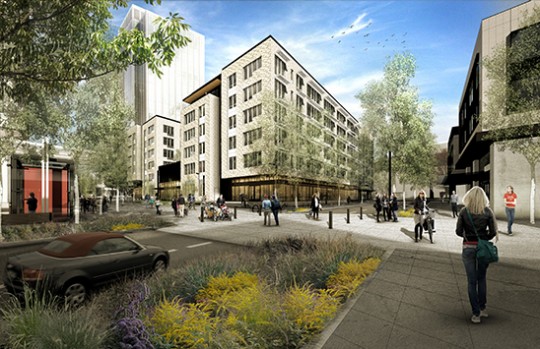
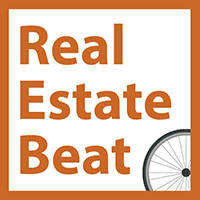
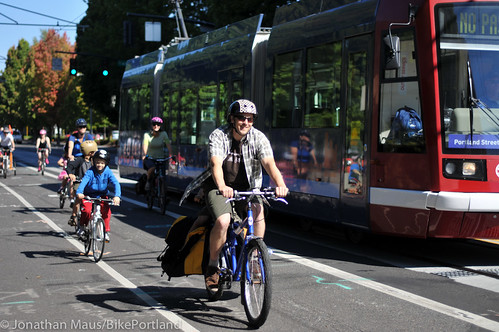

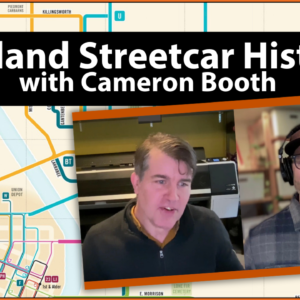
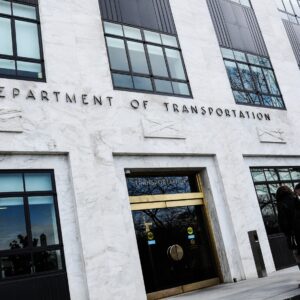
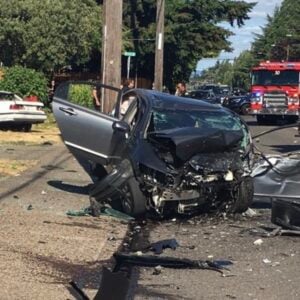
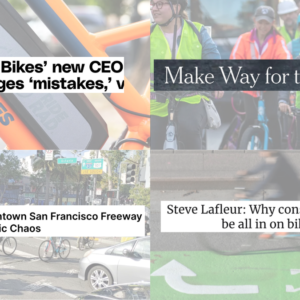
Thanks for reading.
BikePortland has served this community with independent community journalism since 2005. We rely on subscriptions from readers like you to survive. Your financial support is vital in keeping this valuable resource alive and well.
Please subscribe today to strengthen and expand our work.
I’ve seen transit like street car used intelligently and unintelligently. In Portland, I’ve seen it used very much as a tool to increase the tax base by enticing wealthier residents with gentrification. There was a lot of effort to bring the streetcar to South Waterfront. An area which feels mostly unoccupied when I’ve been through there. Now a new bridge is being built directly to that area too. Mind you, I love the idea of a bike/transit only bridge. But why is this huge amount of money being spent where there are few if any residents while Portland east of I-205 has almost no transit investment?
The new streetcar? It was re-routed away from a pedestrian-friendly corridor to MLK which is vastly more dangerous which makes the streetcar less effective. This was done purely for the sake of helping businesses make more cash.
I would rather see less expensive streetcar investment which actually serves low-income people.
Perhaps MLK will become more pedestrian-friendly as the area redevelops into a place where people want to live and work?
only if they take out half the lanes…
The “south waterfront is empty” meme hasn’t been true in years. Try going through there again. In fact, there’s been a large number of units built there since the recession, with many more in the permit process right now. I would say the investment in the streetcar to South Waterfront is already paying off handsomely.
“…There was a lot of effort to bring the streetcar to South Waterfront. An area which feels mostly unoccupied when I’ve been through there. …” Aaron
Gradually, more people will move in. Good jobs are up on the hill, and some in Downtown. What’s out there for work, east of I-205, that a streetcar system would support access to? South Waterfront now has the tram to the hill, and the streetcar to Downtown.
I don’t know how true it is that streetcar systems support a transition from the long term standard practice of spread out community planning and building, to higher density community building and planning, but I’d like to think such systems help with this. Never the less, the tracks are miserable to deal with in traveling by bike. Hopefully, some ingenious person can come up with a way to make them easier to cross with bikes.
A complete revolution of redevelopment has begun along Grand/MLK since the streetcar began construction. I have worked near Rejuvenation since 2008, and nearly every block has something going on, from fixing up unused buildings for new office/creative spaces, to new restaurants, to many new mixed-use buildings. Many of these buildings have been unused or underused for years, and this redevelopment is bringing a lot of jobs, amenities and people to this corridor. Traffic is beginning to be tamed, too with a couple of new signals at the Hawthorne and Morrison bridges. This functioned as a high-ish speed, highway through town, and it is fairly quickly becoming more of a pedestrian-friendly commercial street. From what I have observed, the streetcar tool was used very effectively along Grand/MLK and the Lloyd. It seems too early to judge the South Waterfront, but with the Zidell property getting ready to develop, even that looks promising.
Previously, MLK/Grand was in no-way pedestrian friendly. The addition of streetcar and subsequent (re)development is beginning to change that. A lot bike/ped infrastructure has been totally neglected, though. There are no decent east/west crossings for bike routes like Lincoln, Salmon or Ankeny. There is extremely poor bike/ped connection over I-84. All of the bridges remain mini speedways with high traffic speeds (no enforcement), too many traffic lanes, and ridiculous highway-style on- and off-ramps with no or poor ped ramps/sidewalks. For the most part, I think the streetcar is an effective tool that was sued well, but Portland really catered to the development community and has so far neglected the bikes and pedestrians
Instead of a streetcar on Broadway, Sandy or MLK, which will serve well-to-do Irvington and Kerns with a mode of transportation slower than buses, we should focus on a MAX on Powell to I205, which has the potential to serve not only inner SE, but outer E Portland, Clackamas and Gresham.
Imagine commuting via streetcar south on MLK to downtown from Killingsworth. At the current rate it travels on the CL line it would take more than a half hour, much longer than the bus.
We need transit that serves lower income neighborhoods as well as something that competes with cars, practical for commuting more than 10 blocks, and something that does not focus development solely within the city core. It is possible to make a comment on the streetcar and Powell Corridor routes here:
http://www.portlandmaps.com/bps/cpmapp2/
Was cycling better in the Pearl before or after the streetcar/condo building frenzy?
http://www.inthepearl.com/Home/PearlDistrictHistory
Before 2001, there really wasn’t a Pearl District. North of Lovejoy had no streets! It was a big dirt lot.
Before, like, ’97? there were _freight_ tracks everywhere and sometimes even trains. Cobbles too. Now those were some rough crossings. (Anybody who cares can fix the date)
MLK has the most redevelopment potential – lots of multistory, historic structures that were being used for low-rent purposes such as warehousing. MLK is exploding right now, especially with the new Burnside Bridgehead projects coming online.
Say what you will, but development has absolutely followed the Portland Streetcar. First the Brewery Blocks, then the Pearl, South Waterfront, and now the Central Eastside. The city has been very smart about this strategic urban investment.
One of those includes a 21-story apartment building:
http://forum.skyscraperpage.com/showpost.php?p=6337076&postcount=794
Block 75:
http://placesovertime.wordpress.com/2014/01/19/in-the-works/
Dumbbell:
http://www.bizjournals.com/portland/blog/real-estate-daily/2013/10/meet-the-burnside-bridgeheads-next.html?page=all
419 East Burnside:
http://placesovertime.wordpress.com/2014/04/04/arcade-games-are-better/
Also needs mentioning is the Red Lion renovation.
More news:
http://www.bizjournals.com/portland/blog/real-estate-daily/2014/08/central-eastside-expected-to-lead-portlands.html
While I agree with a lot of what you are saying. I think the street car and new bridge were routed to South Waterfront just as much because OHSU is the biggest employer in the city (as well as wanting development).
I work on NW Lovejoy and am always surprised/pleased to see how packed the streetcar is. It’s also pretty quick moving.
Street cars should be paid for with development funding. Transportation funding, in our limited world as it is, should be used for ACCESS TO these said streetcars. If the private sector (with some public bonding paid back through fairs/private sector growth) can not fund them, we should not use our scarce transportation dollars on more streetcars until our active transportation network is complete enough for the whole city and everyone has access to high quality bus systems.
Then we can talk about more streetcars. I do however disagree with Aaran on the South Waterfront. That area when complete will have over 5,000 jobs and 15,000 residents I believe. This is a case of a brownfield NEEDING the infrastructure investment first in order to spur development. This way the new residents come into the area with “eye’s wide open” realizing that owning a car will be a MAJOR expense for them and that due to the streetcar and MAX they do not need one. There are very few other areas of the city like this (extending the streetcar north on 23rd to the new high density development in NW is the only example I can think of right now.)
The MLK and South Waterfront extension lines that are on the Comprehensive Map are both poor uses of Transportation dollars right now….development money, maybe…..but I think both areas can grow on their own at this point. The money would be better spent add high frequency buses and cycle-tracks on 122nd and Outer Powell.
“Transportation funding, in our limited world as it is, should be used for ACCESS TO these said streetcars.”
This. Let’s not pretend everyone in Portland uses streetcars. But let’s fund transit projects that can help people–in ALL parts of Portland–get to them.
1. Installing street car tracks in such a manor that they pose a serious risk to cyclists is irresponsible and outrageous
2. Street cars are a tool designed to funnel money from taxpayers to landowners and developers who then recycle some of that money back to politicians who supported street cars.
3. For the price of the street car system we could have nicer things for transit dependent folks: lower fare for lower income people, 24 hour bus service for shift workers, etc.
More than a little obtuse, self-serving, and tendentious, Chris.
Imagine $150,000,000 spent on street improvements, for example, repaving Main as the chief bike exit from the Hawthorn Bridge, plus a whole lot of other useful and much needed improvements, instead on the Eastside–whatever. When Portland Streetcar, Inc., wins (always), cyclists lose, in every way possible.
Chris, we relied on you, as a member of Portland Streetcar’s, Inc., Citizen Advisory Committee, to bring our concerns to the board of Portland Streetcar, Inc., of which you are a member too, but which we are forbidden to appear before. You did a lousy job.
And–wait–members of City Council, including the mayor, plus the chief of TriMet, are members of the board of Portland Streetcar, Inc., with whom they sign various contracts, thus violating a fundamental principle of contract law, that one can not be party to both sides of a contract. All those contracts are invalid. And so it goes.
We are more than a little tired of your flackery for Portland Streetcar, Inc., Chris, and humbly inquire as to what way and as to how much you are being compensated for your services to them.
You realize that Chris Smith is also a member of the Portland Planning Commission, board member of the Portland Streetcar, and former Chair of the Portland Streetcar Citizens Advisory Committee?
And you would really rather the city spent $150 million on repaving rather than improved mass transit? You are kidding. America gets like a D+ grade on its mass transit as it is.
[source: http://www.infrastructurereportcard.org/a/#p/transit/overview%5D
The problem, as I see it, with the street car and short trips is that it comes so infrequently and goes so slowly, I’m almost always better off doing my short trip on foot.
And that street car that is so full at NW Lovejoy…it empties at PSU. There has got to be a cheaper, easier, better way to get PSU students from NW to PSU.
There was, it was called the 17, and it was canned by TriMet in 2012.
There is also a significant amount of traffic on trains between PSU and OHSU, particularly in the afternoon.
“And that street car that is so full at NW Lovejoy…it empties at PSU. There has got to be a cheaper, easier, better way to get PSU students from NW to PSU.”
Isn’t that sorta the point of mass transit? Move a lot of people from one area to another? You sure it’s all students?
IMO the streetcar is as much a development tool as much as it a transportation system. I would be fine if the businesses who benefit ended up paying more of the cost, at least in tax-increment financing.
Maybe we could work on making the streetcar a better transportation system? One of the points about it being so slow is that (IIRC) it often doesn’t get signal priority – which MAX does get, even downtown. So how about reprogramming the signals along the line so the streetcar can preempt other vehicle movements just like MAX does?
The streetcar already has signal priority in some places. For example, it can hold green lights longer at Burnside which helps the streetcar avoid long waits while also flushing traffic out ahead of it during congestion periods.
The businesses within a couple blocks of the streetcar lines DO pay a special tax assessment for the privilege.
I cannot get over how dreary those boxy concrete buildings look in the picture! I hope they are planning on more trees. Reminds me of housing projects in Chicago. Sigh. Must TOD be such an eyesore?
They should have done this instead:
http://d3u5xmnnxiuz0w.cloudfront.net/wp-content/uploads/2013/01/RaQgT.jpg
How cute- Chris I thinks that ugly German cement boxes and Levitt Town are the only two possible development styles.
Nothing says “healthy connected city” like putting in a transportation method that is frequently slower than a mild walk.
You want a healthy city encourage safe and protected biking, and add a roof over bikers heads so the drizzle is palatable.
The streetcar is for old women and men that dislike buses, dislike using their legs, and dislike even the faintest idea of the elements.
I work on NW Lovejoy and am always surprised/pleased to see how packed the streetcar is. It’s also pretty quick moving.
“…The streetcar is for old women and men that dislike buses, dislike using their legs, and dislike even the faintest idea of the elements. …” Indy
So what, you can walk faster than the streetcar. Many people can’t, and not necessarily because they’re “..old…”. Try take a four year old for a walk much over 5 blocks. I’m sure others reading here, can think of many reasons why having a streetcar available to ride, instead of having to hoof it, take the bus, or bike or drive, is a definite asset to a modern city.
What I don’t understand is why we are using 19th century technology (rails) to guide the streetcar?
The bicycle, hydroelectric dams, asphalt concrete, toilet paper and pneumatic tires were all invented in the 19th century. Should we stop using them too?
So was the automobile.
The “19th century” right-wing meme about rail is getting a little tired. Many of the most important inventions and discoveries – the automobile, the bicycle, the train, germ theory – are “19th century technology.”
Man, you better get over to Germany and tell them to start tearing out these lines and replacing them with highways:
https://www.youtube.com/watch?feature=player_detailpage&v=Oo9-9rm8Tdg#t=10
I would like to understand why we have streetcars that run on steel wheels and tracks that day after day, and over years and decades, are predictably maiming thousands of people who ride bicycles instead of streetcars on rubber tires and (safe) concrete like some other cities. Maybe there is a reason. I’d like to hear it so I can at least understand if not change my view.
Not that it’s entirely convincing, but some of the standard arguments for rail vs. rubber tires: 1. The route is pretty permanent, so that a developer is confident he can build next to it and get the benefits of it. A bus line, even an electric one, can be more easily rerouted. 2. Rail vehicles last much longer than buses. They also cost more. I’m not sure of the cost/mile. 3. Rail vehicles can carry more passengers per driver. 4. Rail vehicles have a smoother ride (because the tracks stay smooth longer than a roadway, and perhaps because the the greater mass of the vehicle reduces the vehicle bumping up and down as much). 5. The annoying but seemingly true “Some people will ride rail who won’t ride a bus because of a perceived lower-class, “loser” status ascribed to riding the bus.”
nice summary,Doug. Also, rail beds cost more to build but last far, far longer than roads. Take look at the asphalt at a busstop (Burnside and Grand, for example) compared to the concrete at a streetcar stop.
Let’s talk about something we can all agree on, like helmets.
What is so wrong with busses? why can’t we pay for more bus lines with “clean” propane or electric or whatever busses? We’d get alot more transportation miles for less money with busses….more flexible routing…less hazardous for bikes….
Because transportation advocates tend to be dogmatic. Buses do not make certain business interests wealthy, and there is a child-like attraction to new and shiny toys.
It’s funny that you would accuse others of being dogmatic, given that every single post you ever make follows of the dogma that if it’s happening in the City of Portland, it must be bad.
As a bike lover, I am just trying to provide a balance on a usually one-sided blog. I am sometimes supportive of the city- I helped lobby for parking minimums and my side won. And I am a strong supporter of bike trails like the Springwater- because only total protection from traffic will bring the casual bikers out more often.